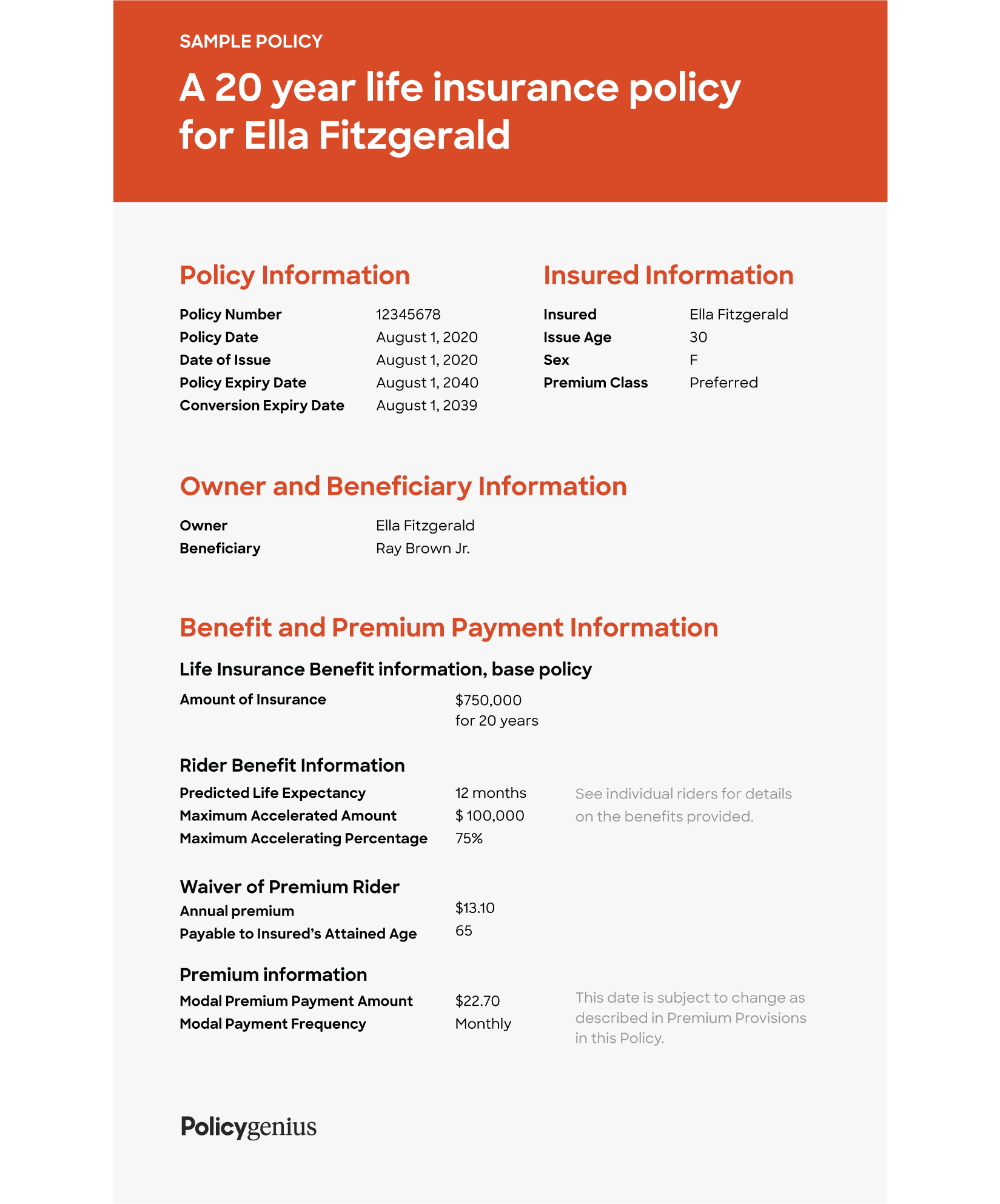Getting life insurance coverage is an important step in protecting your family financially if you die and can no longer provide for them. Understanding your policy to make sure you know how your life insurance works is a crucial step to maximizing your benefits.
Your life insurance policy is a contract between you and the insurance company. It’s a written document that explains how your coverage works. Knowing how the contract is written can help you feel confident about your coverage and your family’s ability to make a claim if they ever need to.
How does life insurance work?
A life insurance policy is an agreement between you and an insurer. In exchange for paying regular premiums, the insurer agrees to pay out a lump-sum of money if you die while the policy is active.
Some policies offer additional benefits like a cash value account or living benefits that you can use if certain criteria are met. All of the terms of your insurance coverage are written out clearly in your policy documents. You’ll receive a copy of the policy documents when your insurance becomes active.
Learn more about how life insurance works
When do you receive your life insurance policy?
As soon as you sign your policy documents and pay your first premium, you’ll get either a physical or electronic copy of your policy, which lays out the fine details of your coverage. The life insurance agent or independent broker you worked with will make sure that you receive all the documentation regarding your policy.
How to read & understand your life insurance policy
Your life insurance policy is a binding document, and as such it has a lot of legalese, but it’s in your best interest to spend time reading through the paperwork to make sure you understand how the agreement works.
We’ll break down some of the details of what goes into a policy and answer common questions.
Key life insurance policy details
Life insurance policies have a lot industry-specific jargon, but there are a few key things you’ll need to look for when you review your policy:
Your personal information: Make sure your name, birth date, and all other personal information is accurate.
The death benefit: This is the amount of money your beneficiaries receive in the event of your death. The death benefit should match the amount you’re purchasing. Check for mistakes now to avoid hiccups down the road.
How much you pay: You'll want to double-check that the premiums are accurate, as that is the rate you'll be paying monthly or annually.
When your policy becomes active: This is the date your coverage becomes active and your policy is in force.

Declarations page
The declarations page is usually the first page of your policy, which contains an executive summary.
Here are the aspects of what will be included in your summary.
The insured or the policyholder
The insured person is almost always the policyholder, but you can buy a policy for someone else, in which case you’re the policy owner and they are the insured.
Essentially, the policyholder is the person who owns the policy and pays the premiums, while the insured is the person whose death would prompt the death benefit payout. The insured and policyholder names will be written out clearly in your policy document.
Policy type
There are two main types of life insurance — term life insurance and permanent life insurance. The type of coverage you bought will be listed in your policy.
Term life insurance: This is generally the most affordable type of life insurance. It lasts for a set number of years, and usually the only benefit is the death benefit that pays out when you die.
Permanent life insurance: This option is usually much more expensive than a comparable term life insurance policy, but is intended to last for the rest of your life and sometimes comes with additional features, like a cash value account that you can use while you’re alive.
Policy number
This number allocated to your policy is good to know — it allows you to identify or confirm your policy when needed. If you ever need to call the insurance company, it’ll be helpful if you have this number for reference.
Policy issue date
The policy issue date is the day that your life insurance application was approved and the insurer extended an offer for coverage to you. Your policy doesn’t actually become active until your policy’s effective date.
The effective date
The effective date of your policy is the date your life insurance policy becomes active and you have life insurance coverage.
This is the most important date on your policy. If you die before your policy’s effective date, your beneficiaries won’t receive the life insurance payout.
Rate class
Your rate class is based on the health classification you receive from the insurer after they evaluate your application. When you applied for coverage, the insurer made a comprehensive evaluation of your medical history, family history, lifestyle, and background to assess your overall risk.
The rate class you’re assigned determines how much you’ll pay for your insurance — and it will be included in your declarations page.
Term length
If you have a term life insurance policy, the length of your coverage will be listed within the policy. If you have a permanent policy, your policy is expected to remain active for the remainder of your life, unless you stop making payments or cancel your policy.
Life insurance riders
Riders are policy add-ons that provide supplemental coverage under special circumstances, like if you’re diagnosed with a terminal or chronic illness. Any life insurance riders that are part of your coverage will be listed in your policy documents, whether you added the rider for a fee or it was included at no extra change.
Here are some common life insurance riders that may be built into your policy or that you can opt-in for.
Disability income rider: A disability income rider replaces a portion of your income if you become disabled and can’t work.
Waiver of premium rider: A waiver of premium rider waives your policy’s premiums if you become disabled and are unable to work for up to six months.
Term conversion rider: Term conversion riders allow you to convert a term life insurance policy to a permanent life insurance policy before the end of the term. It’s usually included in your policy at no additional cost.
Accelerated death benefit rider: If you’re diagnosed with a terminal illness, an accelerated death benefit rider pays out a portion of the death benefit to you while you’re still alive to cover associated medical expenses or the cost of care.
Long-term care rider: A long-term care rider pays out a part of the death benefit to cover the costs of long-term care services. (Not to be confused with hybrid long-term care insurance, which is a combination of traditional life insurance and long-term care insurance.)
Critical illness rider: A critical illness rider pays out a lump sum that is subtracted from your death benefit in the event that you develop a serious illness.
Child rider: A child rider pays out a small death benefit if any of your children die while your policy is active.
Coverage details
This section summarizes the promises the insurance company is making to you and that you’re making to it.
Specifically, it spells out how much you’re going to pay for your policy premiums, and how much the life insurance company will pay out to your beneficiaries in the event of your death.
Premium & payment information
You’ll always know exactly how much you owe for premiums as the details will also be spelled out on your policy.
For term life policies with level premiums that don’t change as you age, you’ll see the cost of paying your premiums monthly or annually.
For permanent policies, which may have variable premiums, your policy will showcase a table with the premiums over time.
Terms & exclusions
Other information included here will be about the grace period — the time you have to make a payment after your premium due date, during which your policy will remain active — and reinstatement terms, which will detail when and how you can reinstate your policy if it lapses.
You might also see any exclusions — for example, a suicide exclusion, which notes that the policy won’t pay a death benefit if you die by suicide within two years of your policy being in force. If you participate in a risky activity like aviation, you may also have an exclusion if you die while piloting a plane.
Ownership & conversion rights
Many policies allow the owner of the life insurance policy to transfer your policy, sell it to a third party, or convert it to a permanent life policy at the end of its term. If this applies to you, your option will be written out in the coverage details section.
Read more about how to transfer your life insurance policy
Beneficiaries
Your life insurance beneficiaries — those who will be filing the death benefit claim and receiving the payout — will be listed in this section.
Along with seeing who’s who in your policy, you’ll also be able to see and update your contingent beneficiaries, what percent of the death benefit your beneficiaries will receive, and if the death benefit will be paid out per capita or per stirpes.
Remember that you can change your beneficiaries and/or how the payout is distributed to them at any time. Any updates you make to your life insurance beneficiaries will be reflected in this section.
Learn more about the history of life insurance



